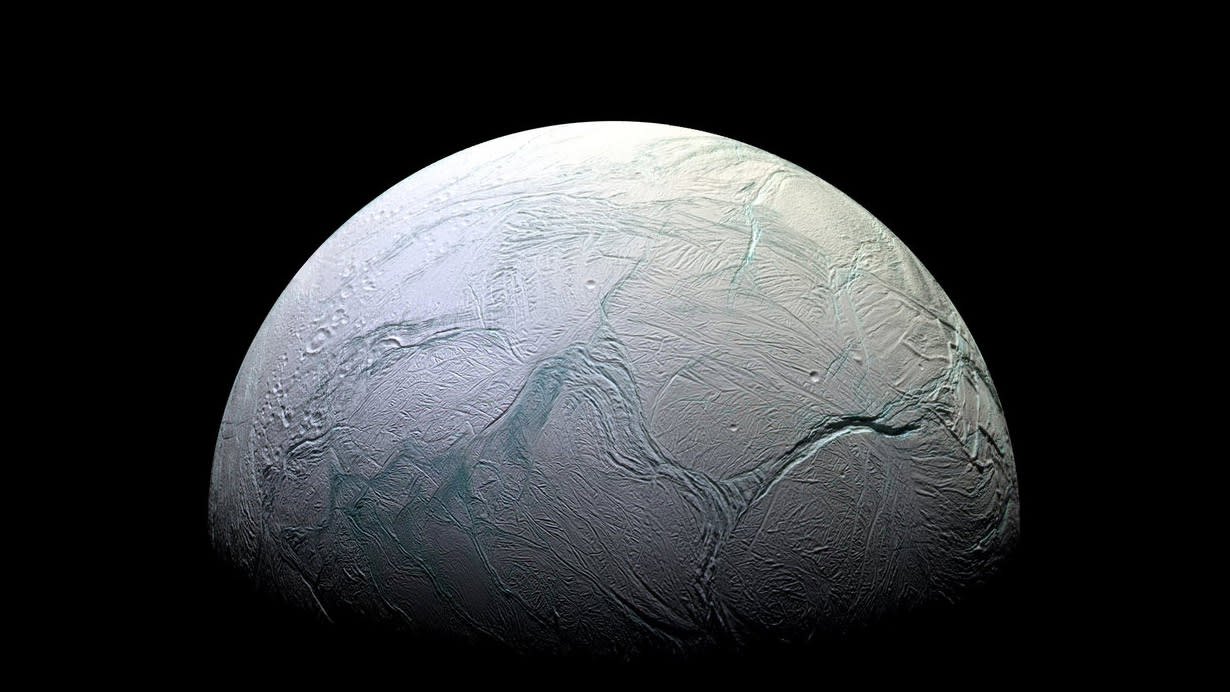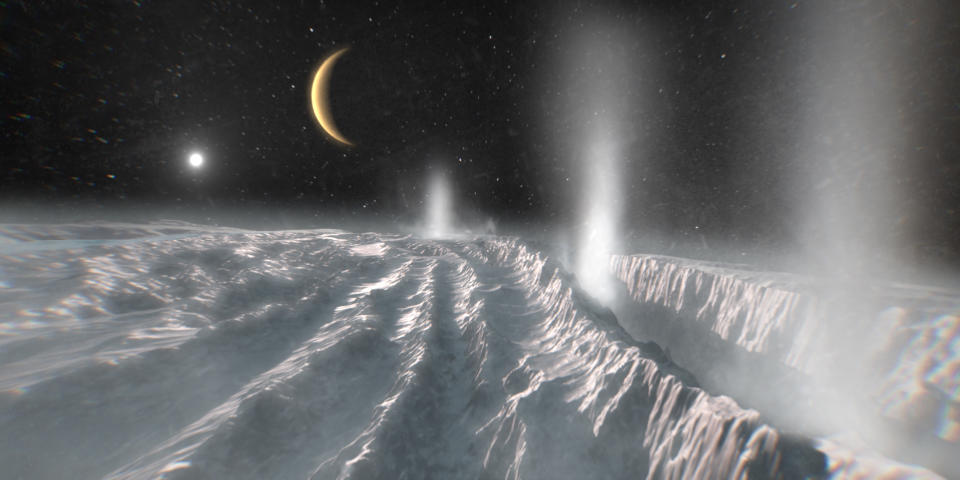Life on Enceladus? Europe eyes astrobiology mission to Saturn ocean moon

Europe could be heading to the Saturn moon Enceladus in search of life, according to a new report from planetary scientists who are masterminding a future large-class mission to the outer solar system.
The European Space Agency (ESA) is exercising considerable forward-thinking with its "Voyager 2050" program, which describes the scientific goals and missions for the middle of this century. Its overarching theme of "moons of the solar system" was chosen in 2021, and now an expert report has recommended that Enceladus should be the primary target.
Enceladus is a 309-mile-wide (498 kilometers) icy moon of Saturn. In 2006, the Cassini mission discovered that giant plumes of water vapor are spewing out from deep fractures in the surface, nicknamed "tiger stripes," located near Enceladus' south pole. The plumes are the result of Saturn's gravity stretching and squeezing Enceladus' innards like putty, injecting energy into the moon's interior to keep water liquid in a global ocean and periodically squirting some of that water out through the tiger stripes, like squeezing water out of a bottle.
Related: Saturn's moons: Facts about the weird and wonderful satellites of the ringed planet
ESA convened a 12-person panel of planetary scientists from across Europe and chaired by Zita Martins, who is an astrobiologist at Instituto Superior Técnico in Portugal, to asses the science that could be gained from venturing to Enceladus, its fellow Saturn satellite Titan or the Jupiter ocean moon Europa. Meanwhile, engineers at ESA's Concurrent Design Facility (CDF) explored what kind of mission would be most realistic given current and near-future technologies.
"The search for habitable conditions and for signatures of life in the solar system is challenging from a science and technology point of view, but very exciting," said Martins in a press statement.
From both a scientific and technology point of view, Enceladus came out on top, followed by Titan and then Europa.
Enceladus has all the ingredients necessary for a potentially habitable environment. Liquid water — check. Organic molecules — check. A source of chemical energy to fuel life — check.
The report suggests that a mission to Enceladus (or Titan) be composed of both an orbiter and a lander. They'd be launched separately on Ariane 6 rockets and then rendezvous in Earth orbit before heading for Saturn. Once there, they'd perform several flybys of Saturn's other moons that could harbor oceans, such as Dione, Mimas and Rhea, before closing in on their target of either Enceladus or Titan.

If Enceladus were chosen, the lander would touch down in the south polar region near the tiger stripes and collect samples of the ocean that have snowed back onto the surface from the plumes. Alternatively, if ESA wished to dispense with the lander for budgetary reasons, the orbiter could fly through the plumes and sample material that way. This has been done previously, with the Cassini spacecraft. Although Cassini did not have the instruments capable of detecting life, it did find organic molecules from the ocean within the plumes.
A lander as part of a Titan mission would focus on touching down in an empty lakebed that seasonally fills with liquid hydrocarbons such as ethane and methane, and sampling the sediments there. However, getting into low-Titan orbit where an orbiter could also sample the moon's upper atmosphere is challenging because of the significant delta-v (change in velocity) needed, which would require a more complex spacecraft with greater fuel reserves, which in turn increases the mass at launch.
It's also worth pointing out that NASA is already developing a mission to Titan, namely a quadcopter called Dragonfly that's scheduled to launch in 2028 to explore the skies and surface of the big moon. Also, while Titan certainly possesses the organic chemistry that could assemble life's building blocks, the moon's astrobiological potential has recently been questioned in research that suggested that not enough organic material from the surface would reach its underground ocean.
Related: Titan: Facts about Saturn's largest moon
RELATED STORIES:
— Finding life on Saturn's moon Enceladus might be easier than we thought
— Saturn's moon Enceladus has all the ingredients for life in its icy oceans. But is life there?
— This snake robot could hunt alien life on icy moons like Saturn's Enceladus
Europa Clipper that will blast off in October 2024, will already maximize the science that can be conducted from close flybys of Europa. To significantly further the science that can be done at Europa would require a lander, but estimates place the lifetime of any lander on the irradiated surface of Europa at just 10 days using current radiation shielding technology. Both ESA's scientific and CDF panels concluded that such a mission is not feasible at the current time.
If ESA can pull off an Enceladus mission, it would be a huge, potentially history-making achievement, depending upon what it finds.
"An investigation into signs of past or present life around Saturn has never been achieved before," said Carole Mundell, who is the director of science at ESA. "It would guarantee ESA leadership in planetary science for decades to come."
The full report can be found on the European Space Agency's website.

